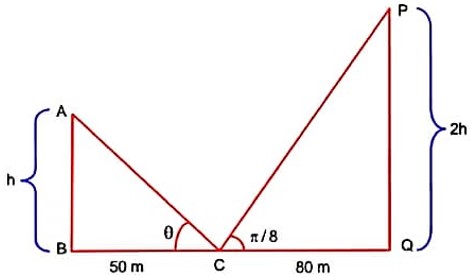Let AB and PQ be two vertical poles, 160m apart from each other. Let C be the middle points of B and Q, which are feet of these two poles. Let
and q be the angles of elevation from C to P and A, respectively. If the height of pole PQ is twice the height of pole AB, then tan2q is equal to
Let AB and PQ be two vertical poles, 160m apart from each other. Let C be the middle points of B and Q, which are feet of these two poles. Let and q be the angles of elevation from C to P and A, respectively. If the height of pole PQ is twice the height of pole AB, then tan2q is equal to
Option 1 -
Option 2 -
Option 3 -
Option 4 -
-
1 Answer
-
Correct Option - 3
Detailed Solution:
Similar Questions for you
16cos2θ + 25sin2θ + 40sinθ cosθ = 1
16 + 9sin2θ + 20sin 2θ = 1
+ 20sin 2θ = 1
– 9cos 2θ + 40sin 2θ = – 39
48tan2θ + 80tanθ + 30 = 0
24tan2θ + 40tanθ + 15 = 0
-> ,
So will be rejected as
Option (4) is correct.
12x =
is the solution of above equation.
Statement 1 is true
f(0) = – 1 < 0
one root lies in , one root is which is positive. As the coefficients are real, therefore all the roots must be real.
Statement 2 is false.
tan2 A = tan B tan C
It is only possible when A = B = C at x = 1
A = 30°, B = 30°, C = 30°
a = sin−1 (sin5) = 5 − 2π
and b = cos−1 (cos5) = 2π − 5
∴ a2 + b2 = (5 − 2π)2 + (2π − 5)2
= 8π2 − 40π + 50
sin 2 + tan 2 > 0
Let tan = x
Taking an Exam? Selecting a College?
Get authentic answers from experts, students and alumni that you won't find anywhere else
Sign Up on ShikshaOn Shiksha, get access to
- 66k Colleges
- 1.2k Exams
- 680k Reviews
- 1800k Answers

